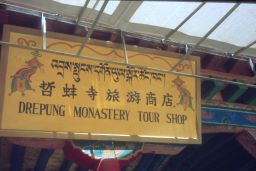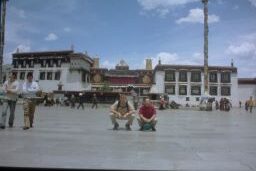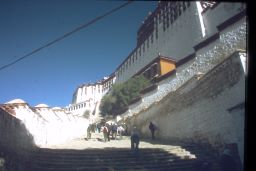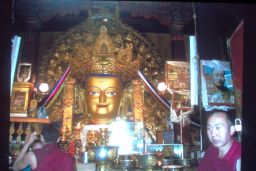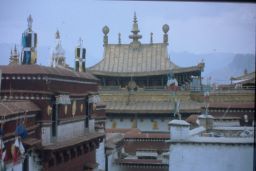
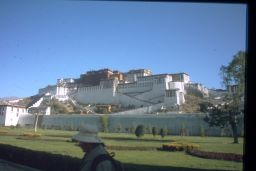
June 3, 2005
Two days ago, I was in Tibet with JR. I am really glad he suggested that we go, because it was a nice addition to our coastal visits to “modern Asia.” Indeed, when we landed in Chicago, it almost reminded us of every other city we visited in Asia–except for Lhasa.
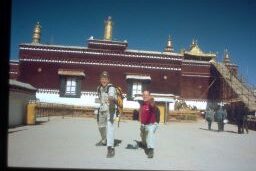
As I mentioned, we went early Tibet (early ta rise, early ta bet), but it’s a long way from Beijing–at least 50 years and several thousand miles. It left me breathless, both literally and figuratively.
Literally, Tibet resembles Wyoming. Lhasa (400,000 population) bills itself as the world’s highest city. It is on the Tibetan plateau, which is only 11,800 feet–I say only, because it’s surrounded by mountains that must be over 15000-18,000 feet. It was hard breathing because we were consuming less than 60 percent of the oxygen at sea level, and when we got there, we had an acclimation day. We spent the day driving from the airport (on what I understand is the best paved road–I don’t know how the Chinese managed to “liberate” the city since Tibet is still almost impenetrable), walking around the old city (our hotel was in the center of the old city, near the main monastery), and collapsing around 7 pm, a product of a late night in Beijing the night before and the altitude. Those of you who know my habits, realize that I don’t sleep that much ever–woke up at 7 the next morning! Scenery is high desert–and the cowboy hat seems to have replaced the local scarf. It also took breath away because instead of incense, the Tibetans burn yak butter, which is pungent (they also have yak tea, which the guidebooks say is an “acquired taste”–needs more than one day to acquire the taste, apparently).
it took our breath away figuratively because it’s much different than the rest of China. That it is part of China is a tribute to the idea of the middle kingdom, which is China’s name for China–between heaven and earth. Whatever has been Chinese (ever), is and must be Chinese  today (As I mentioned, European domination is recent–and over). Ther
today (As I mentioned, European domination is recent–and over). Ther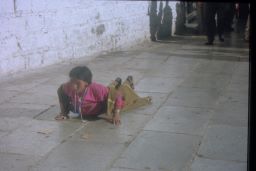 e is a
e is a
monument to the 16th century treaty by which the Ming emperor defined relations with the Dalai Lama as uncle/nephew. In the 1950s, China “liberated” Tibet, which is why there is a huge monument in Lhasa, and not always subtle reminders that China is the dominant power in the region. Our guide, who is of Tibetan nationality, told us he had to be careful in public because there were spies everywhere. Since riots in 1989, the government has been wary of Tibetan Buddhism, taking over festivals and controlling the monasteries.
The Buddhist palaces and monasteries are breathtaking, too. The Buddha as I mentioned takes different forms in different countries, absorbing the previous deities, and thus in Tibet are wondrous bodhisattvas (people who could have achieved Nirvana, but have stayed on earth to help others achieve enlightenment), with horse heads, 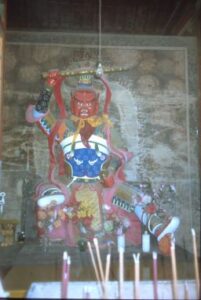 and bear heads, and are demonic–I’ve not seen them elsewhere.
and bear heads, and are demonic–I’ve not seen them elsewhere.
We spent 2 days in Lhasa, literally stupafied (look that up) by 17th century monasteries and palaces.
The Potala Palace is stunning, as you can see (it had one “outhouse” that was basically a seat over a 200 foot drop). The main square (crawling in front of it is standard) as I recall has a monument to the first treaty with China, in which Tibet said it was the little brother, China was the big brother. China never forgot and big brother returned in force in 1950. The Dali Lama fled.
The long journey back to the Midwest started from Lhasa (LXA is the airport code) and took us back to a frantic night in Beijing with a wonderful driver who spoke no English, but who was really helpful and like most Chinese appreciated my Chinese, or efforts to make myself understood.
JR pointed out that the cab looked like a government car with tinted windows. Sure enough, I looked at it and realized it was a “hong qi” or red flag. I did not know they still made the car, which at one time was the official car. That was neat.
We left Beijing and 30 some hours later; we were back in the Midwest. Confucius once said (from the vantage point of Mt. Tai, one of the sacred mountains–I have been there!) the earth is small. Obviously, he never did international travel.
It’s good to be home, but it was fun to wander around Asia and realize once again the challenge of the 21st century!
